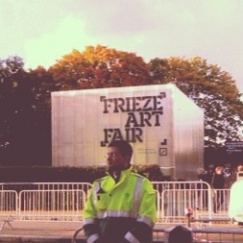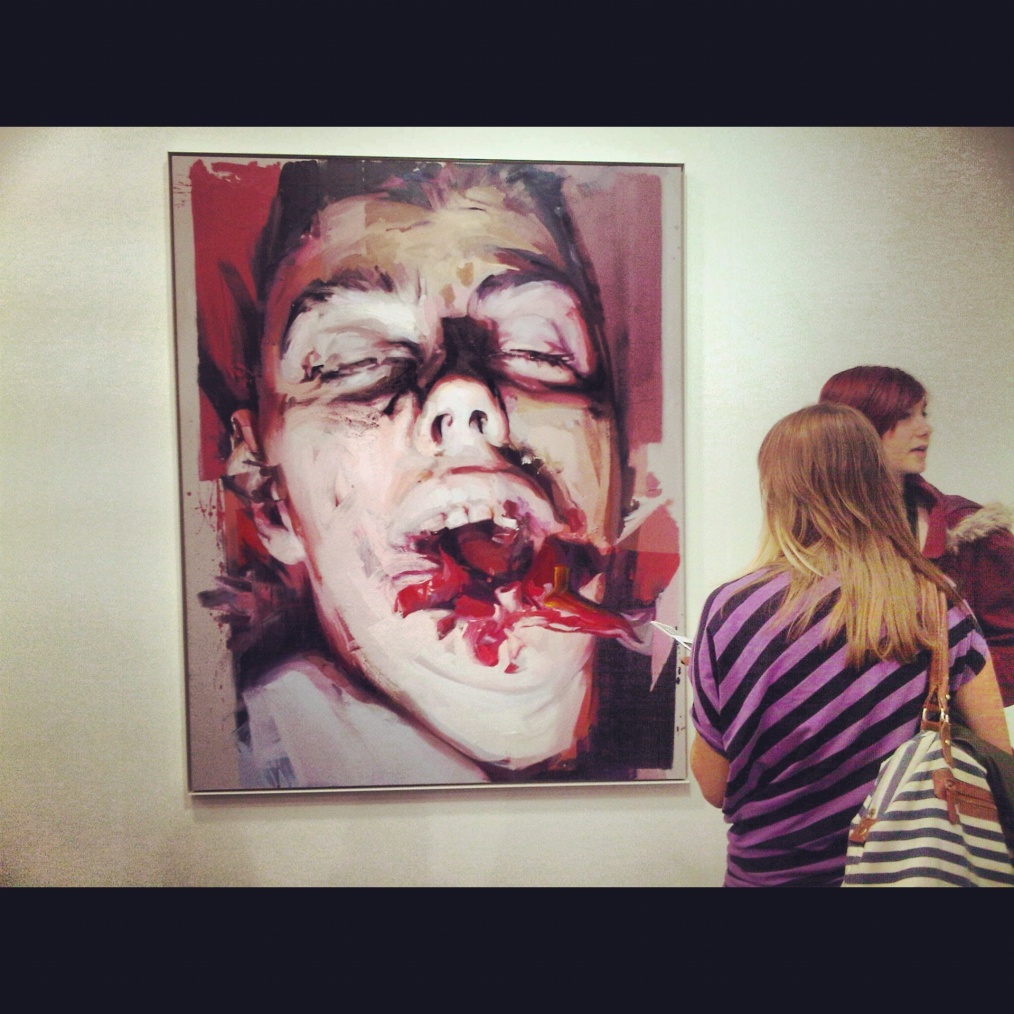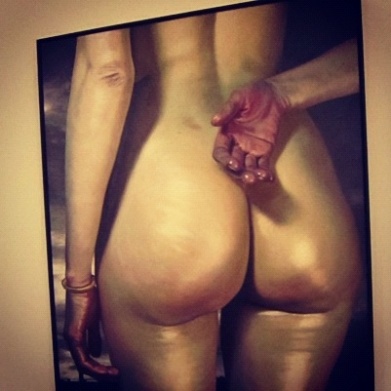MACE students and I managed to get to the Frieze Art Fair 2012, we all arrived excited and ready to take in all the art. Our tickets only allowed us to have access to the fair for two hours, from 5pm to 7pm. We had the privilege to walk amongst the 5pm VIP guests, I could not tell the difference between who was VIP and who was trying to be. After the first hour I was ready to leave. Despite the headache I had, due to the typical bright lights of the art fair, I managed to stay the whole two hours.
We found the Gagosian Gallery from New York art booth. I was drawn to this painting (above) however, there was no caption and it was hard to tell who was representing the gallery. It was hard find any handout or books on the artist. Fellow Mace Students and I had a strange feeling when we entered Gagosian’s booth. We felt unwanted and unimportant. I got a sense of ‘we know at 5pm to 7pm there will be no real buyers, so we can relax and not make an effort’. Was there no captions for the artwork because they expected us to already know the Gallery and to recognise the artist represented without having to ask.
I was quite surprised to not see many red dots on the captions indicating artwork sold or other coloured dots indicating artwork reserved.
Frieze was my second Art Fair experience, I had the opportunity to work as a volunteer and represented Schoeni Art Gallery, Hong Kong at the Hong Kong Art Fair 2012 in May. I found that at both Art Fairs there was too much art to see and I found myself swimming through the lanes quickly as a result of lack of interest. I found the gallery representatives unapproachable and at times judgemental, especially when they stare at you as you walk by or took a photo. At the Hong Kong Art Fair we were told to always be alert, helpful, and engage in conversations with visitors, invite them to see all the artwork and meet the gallery owner. This friendly visitor interaction was encouraged throughout the whole day and not only when VIP’s were scheduled in. I did not find this friendly visitor and gallery staff interaction constantly throughout Frieze, but I am not saying that it wasn’t there at all.
Being an amateur and new to London’s Art World it was not easy to recognise the VIPs with the 5pm tickets. In Hong Kong the staff, Gallery staff, Sponsors, Journalist had visible photo identification cards hanging around their necks with different colours indicating who they were. It would of been interesting to see how different the atmosphere was when it was VIP only sessions.
 Mace students and I had the privilege to listen to Art Market Analysis Anders Petterson, Founder and Managing Director of ArtTactic http://www.arttactic.com/, about the Art Market and prepared us for Frieze. After two hours with Petterson we found ourselves ready for the fair, he discussed the politics of Art Fairs, which includes not only the placements of the galleries art booth at the fair but also how the gallery is chosen. It’s all about reputation. For a gallery to be picked for an Art Fair the people who choose the galleries have to consider the reputation of the artists represented and what has the gallery achieved in the art world.
Mace students and I had the privilege to listen to Art Market Analysis Anders Petterson, Founder and Managing Director of ArtTactic http://www.arttactic.com/, about the Art Market and prepared us for Frieze. After two hours with Petterson we found ourselves ready for the fair, he discussed the politics of Art Fairs, which includes not only the placements of the galleries art booth at the fair but also how the gallery is chosen. It’s all about reputation. For a gallery to be picked for an Art Fair the people who choose the galleries have to consider the reputation of the artists represented and what has the gallery achieved in the art world.
Personally, I find Art Fairs pretentious. It’s about galleries and artist maintaining or boosting their reputation. It’s about art sales, galleries competing each other for sales. Not only does the Artist and Galleries have pressure but the Art Fair organisers have pressure in keeping certain top galleries for the art season. For some of the visitors its about being seen at the art fair and its the time to become an art critic. Despite being considered pretentious Art Fairs are also considered as positive events within the art world. Art fairs give emerging artists and galleries the opportunity to launch their reputation into the prestigious art world. Art fairs bring different art cultures together in one space. It gives people the opportunity to network. Most importantly, they are part of the growing Creative Economy.
— * —













